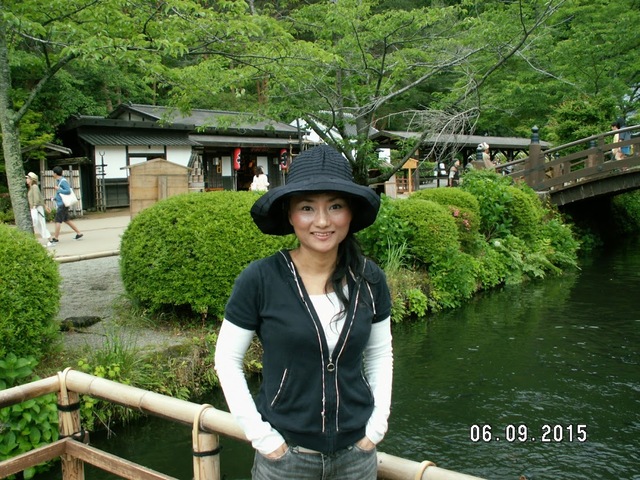人の思考パータンは時代の変化に伴い
影響される受動態の性質を持つかもしれない。
Humans thought it might have a passive pattern
influenced by changing generations.
アナログ時計を見ると時間を示す針があって、
時間の流れが見える。
When looking at an analog clock,
there are hands for indicating the hour, minute, second,
and it shows the flow of time.
秒針が一秒一秒動くのを見ていると
一秒が案外長いなと感じて驚かされる。
Watching the hand moves from one second to another
makes me astonishing that the one second is unexpectedly longer than it is.
ところが、デジタル時計は秒と秒の間の動きが見えず、
突然のように現在の時刻が表示される。
However, a digital clock abruptly displays current clock time only
and it does not show the movement of second to seconds.
デジタル式には時間、分、秒が瞬時に表れて、
過ぎた時間は存在していなかったように完全に消えてしまう。
On the digital system, hour, minute, second is appear instantly
and they completely disappear like the passed time even never existed.
時間の経過が見えず、常にその時刻しか見せていない。
The passage of time invisible and shows only the current clock time.
私は便利なデジタル時計よりは、
時計らしいアナログ時計のほうが好きだ。
I prefer an analog-style clock than a convenient digital one
which is more suitable as a clock.
アナログ時計は12時間の経過がひと目で見えるし、
計画的に時間を使えるのに約立つからだ。
Because analog clock shows the passage of 12 hours at a glance
and useful for planning time to use.
たまに、時計の針が動くのをじっと見てしまう時がある。
Occasionally, I stare at the clock hand movement.
時計を眺めている1分がとても長く感じられるし、
1分1分がとても大切に思えるからでもある。
It is because as I look on the clock,
one minute comes to feel longer and
each of one minute becomes pretty precious.
私達の考えや意識もデジタル時計の時刻表示版のように、
突然現れては嘘のように消えてしまう。
Like the digital clock display,
our thoughts and consciousness also suddenly pop up
and be gone like a lie.
一つの考えに前後関連があるように思われても、
考え自体の全面像を巨視的に視ると
記憶の断片に過ぎないことが多い。
Even though a thought seems to be related consequences,
but it is often only a fragment of memory
as perspective it microbially
to grasp the whole picture of the thought.
過去のあるできごとが感情と強く結び付くと記憶に鮮明に残り、
意識されることが多くなる。
When a past episode combines with emotions strongly,
it remains vividly in-memory system and becoming more conscious.
その記憶が今の感情と更に結びつき、感覚の連鎖を作る。
Such memory knotted up with current emotions additionally,
creating chain reactions to sense.
私達の意識は時間の経過が基盤になって、
過去から残された記憶が空中に飛び交うイメージの世界に似ている。
Our consciousness is primarily based on the passage of time,
and it resembles the world of the image
in which the leftover memories from the past
flitting around in the space.
意識自体には秩序が無く、
ランダムに飛び跳ねては泡のように瞬時に消える。
In the consciousness has no order,
and it jumps and bouncing randomly
then disappearing instantly like bubbles.
意識は常にフルに可動している考えの工場かもしれない。
Consciousness maybe like a fully activated factory
that produces thoughts.
10年か前に、仕事絡みのストレスに潰れそうになった時があった。
Ten years or more than before,
I was almost crushed by work-related stresses.
そのストレスな状況は変えられなかったので、
何か自力でできることがあるだろうかと真剣に解決策を探した。
That kind of stress unchangeable so,
I seriously sought a solution to see if I could do anything by myself.
だが、大部分のストレスに関する情報は、
ストレスは何かを説明していて、
対処方法も漠然としていたので、私には効き目がなかった。
But most of the information about stress was
just define what stress is
and the way to deal with it was also indistinct
so those did not work for me.
効き目の無い知識は無用である。
If knowledge does not have efficacy it is useless.
そこで外部からの知識に頼ることをやめて、
ストレスの根源にある自分の意識について
考え直し始めたのである。
Therefore I quit relying on external knowledge
and began to reconsider my own consciousness
which brunched to stress.
意識は、自分の意識なのに常に部分しか見えない。
The consciousness can see only a part even though it belongs to me.
意識の全貌を見渡すには意識自体の枠から出ないと意識が見えない。
To take an extensive view of the whole figure of consciousness,
it does not allow us to see unless we get out of the frame.
では、どうすれば意識の枠から出られるのだろうか。
Then, how can we get out of the conscious frame?
以下は、私が試したいくつかの方法である。
Below are some of the trials I experimented with.
①楽に座り、動作を止める
1st: sit comfortably and stop moving.
②座る動作を維持する
2nd: retain the sitting motion.
③座る動作に意識が向かなくなるまでじっと待つ
3rd: wait until the consciousness loses attention to the sitting motion.
④目で見えることに意識がどう反応しているかに意識を向ける
4th: direct conscious toward how it reacts to what you see with eyes.
⑤見ていることに慣れると過去のある記憶が突然表れる
5th: when adjusted to seeing,
a memory of the past suddenly popping up.
⑥その記憶にぐっついている感情が何かについて意識を向ける
6th: directing to the conscious to see what emotion is attached to the memory.
⑦その感情を最大に具体化する
7th: maximize the emotion to concrete.
⑧その感情に今も痛みが伴うならその痛みに直面する
8th: if the emotion still accompanies a pain then face to the pain directly.
⑨その痛みが架空の痛みなのか実感なのかを見極める
9th: make clearly sure the pain is a fictional or solid feeling.
⑩浮かんだイメージが記憶なのか今の事実なのかを見極める
10th: ascertain the popped-out image came from
wherein memory or it is the current fact.
⑪断片的に表れる記憶をただ再生させる
11th: let the partly appeared memories replaying.
⑫イメージが表れては消えるさまをただ観る
12th: just watch the shape of the image as it appears and disappears.
⑬記憶が見せる映像のようなイメージをただ眺める
13th: just look over scenery like the image that represented by memory.
⑭そのイメージが過去にあったことか今のことなのかを知る
14th: know the image is happened in the past or is in the present.
⑮いつ起きたかを判断することを止める
15th: stop judging when it happened.
⑯どっちなのかの識別することを止める
16th: stop distinguish which it is.
⑰思えてくることを判断することを止める
17th: stop judging what comes to mind.
⑱考えないようにすることすら止める
18th: stop even the try not to think.
⑲考えているか、考えていないかを確認することを止める
19th: stop checking out whether you are thinking or not.
⑳ただ、その瞬間にいる
20th: just be at the moment.
以上は意識を休ませる順序である。
The above are systematic sequences of resting consciousness.
人によって前後する箇所はあるかも知れないが、
意識を休ませることによって、
結果的にストレスから出られることになる。
Maybe a number of the list moves back or forth
depending on personal cases
but by resting consciousness,
it leads you to get out of being stressed.
要するに、時間の枠の中に閉じこもることから開放されるのである。
In other words, it frees you from stuck in the inside of the frame of time.
時間の外側に自分をおくことができるようになる。
It allows to enable to put yourself outside of the time.
アナログ的なエゴつまり、過去の鎖でつながれて、
自分のエゴの中でしか動かすことのできないことからも開放される。
An ego like an analogic system that chained with past
and mobilizes within one’s ego only, it also will be free.
デジタル的な考えつまり、瞬時に表れて
泡のようにあっけなく消える考えに
無駄なエネルギーを消耗することからも開放っされる。
A thought like a digital system that
appears instantly and vanishes abruptly like bubbles,
it allows you freed from wasting the energy.
アナログもデジタルも時間という現象を表示する方式にすぎない。
Either analog or digital are just ways of displaying the phenomenon of the time.
エゴも意識も生きている時に表れる泡のような現象かも知れない….
Maybe both ego and consciousness are bubble-like phenomena
that appearing while alive….




















